Assignment 2: Evaluating Credible Sources in Leadership Studies
VerifiedAdded on 2021/04/24
|6
|1579
|162
Report
AI Summary
This report, titled "Assignment 2: Credible Sources," delves into the critical importance of utilizing credible sources in tertiary-level academic writing and professional research. The report emphasizes that credible sources are essential for students to gather, research, and apply structurally sound information. It highlights the abundance of information available online and stresses the need to discern reliable sources from unreliable ones. The report explores the significance of credible sources in portraying critical thinking, analytical skills, and sincerity in academic work. The report also underscores how credible sources serve to provide evidence, avoid plagiarism, and meet the expectations of the academic community. The report then compares the credibility of a journal article and a Facebook page on leadership skills, highlighting the journal's detailed information, author citations, and recent updates. The report concludes that the journal article has greater merit and credibility than the social media post.
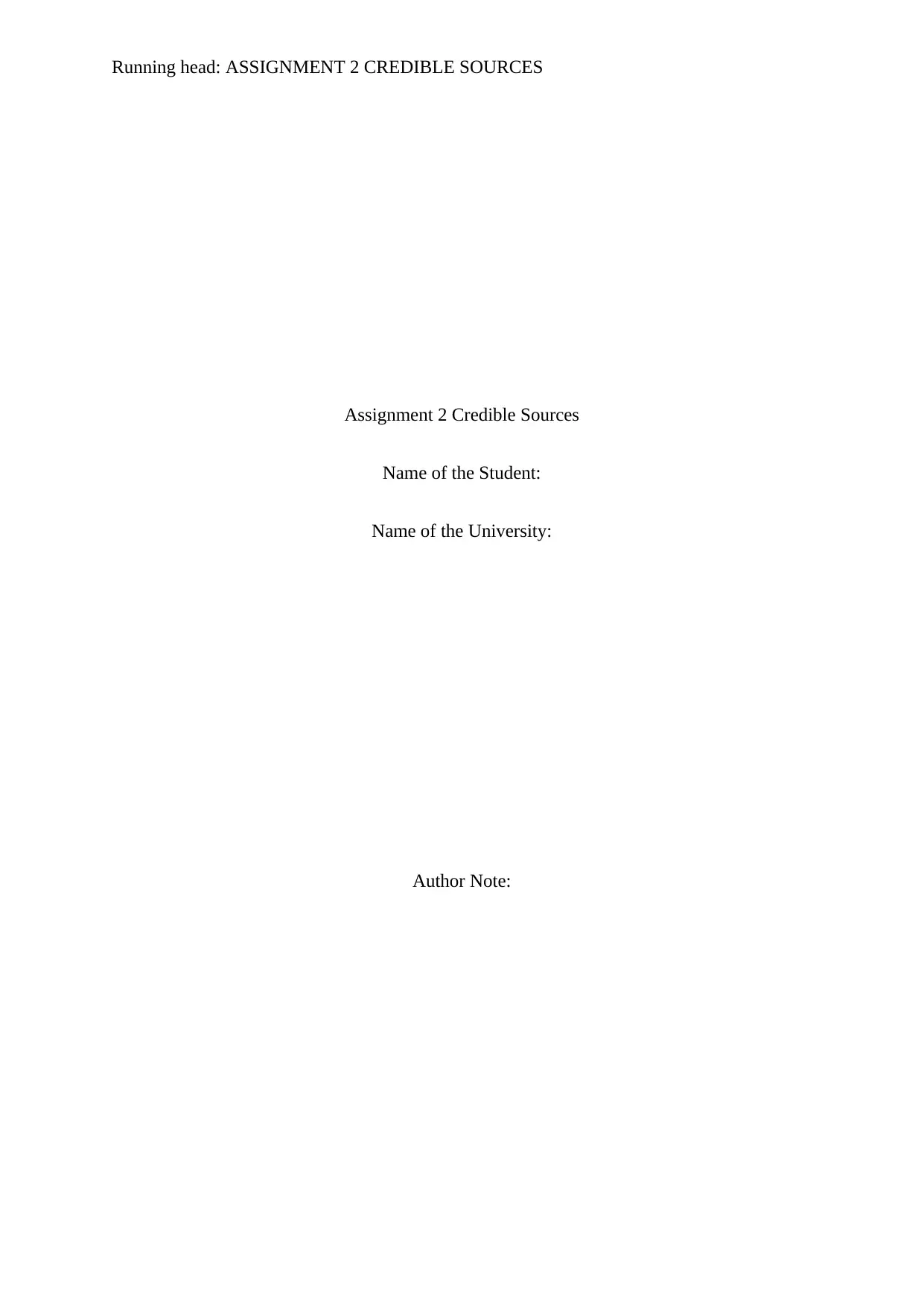
Running head: ASSIGNMENT 2 CREDIBLE SOURCES
Assignment 2 Credible Sources
Name of the Student:
Name of the University:
Author Note:
Assignment 2 Credible Sources
Name of the Student:
Name of the University:
Author Note:
Paraphrase This Document
Need a fresh take? Get an instant paraphrase of this document with our AI Paraphraser
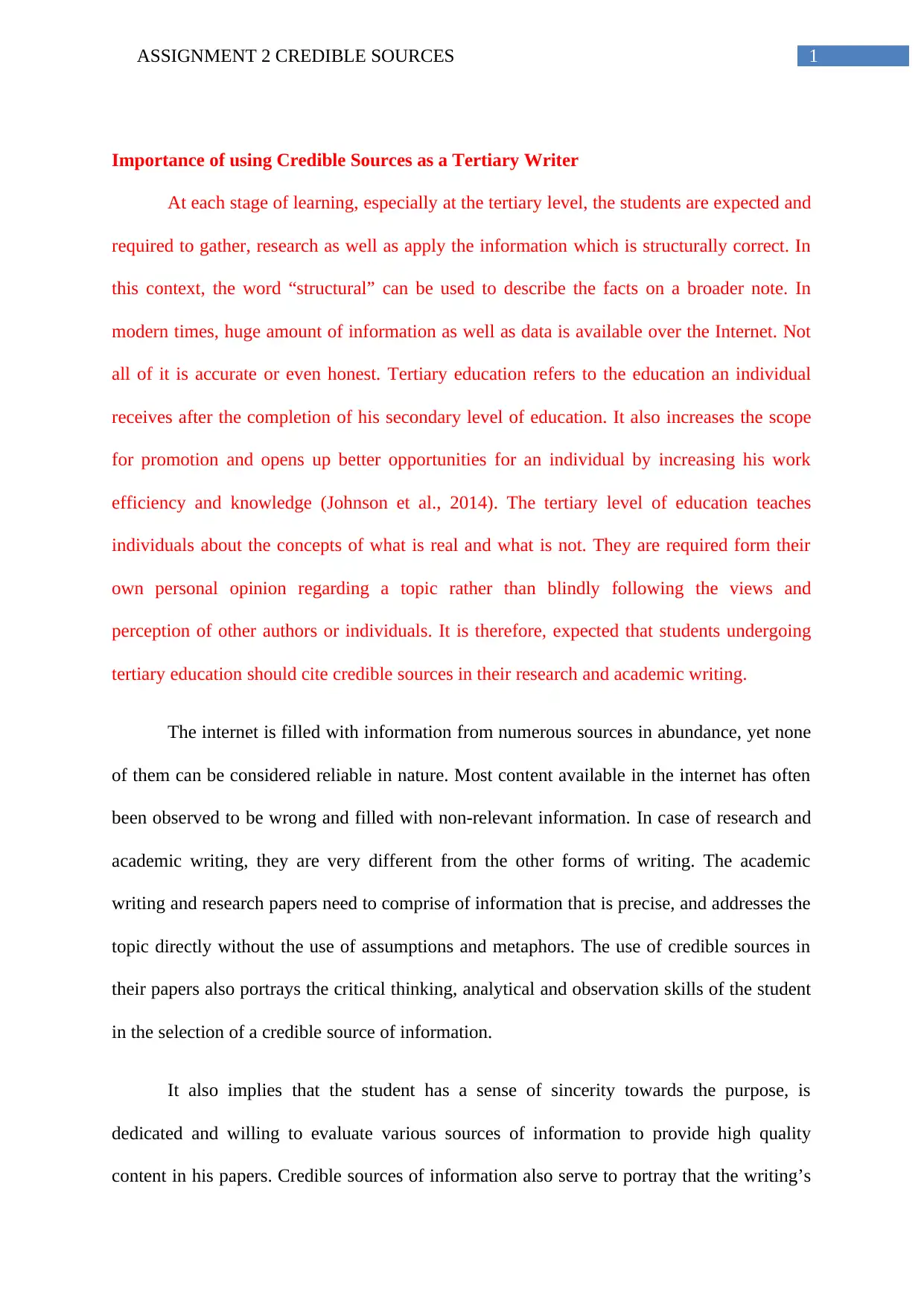
1ASSIGNMENT 2 CREDIBLE SOURCES
Importance of using Credible Sources as a Tertiary Writer
At each stage of learning, especially at the tertiary level, the students are expected and
required to gather, research as well as apply the information which is structurally correct. In
this context, the word “structural” can be used to describe the facts on a broader note. In
modern times, huge amount of information as well as data is available over the Internet. Not
all of it is accurate or even honest. Tertiary education refers to the education an individual
receives after the completion of his secondary level of education. It also increases the scope
for promotion and opens up better opportunities for an individual by increasing his work
efficiency and knowledge (Johnson et al., 2014). The tertiary level of education teaches
individuals about the concepts of what is real and what is not. They are required form their
own personal opinion regarding a topic rather than blindly following the views and
perception of other authors or individuals. It is therefore, expected that students undergoing
tertiary education should cite credible sources in their research and academic writing.
The internet is filled with information from numerous sources in abundance, yet none
of them can be considered reliable in nature. Most content available in the internet has often
been observed to be wrong and filled with non-relevant information. In case of research and
academic writing, they are very different from the other forms of writing. The academic
writing and research papers need to comprise of information that is precise, and addresses the
topic directly without the use of assumptions and metaphors. The use of credible sources in
their papers also portrays the critical thinking, analytical and observation skills of the student
in the selection of a credible source of information.
It also implies that the student has a sense of sincerity towards the purpose, is
dedicated and willing to evaluate various sources of information to provide high quality
content in his papers. Credible sources of information also serve to portray that the writing’s
Importance of using Credible Sources as a Tertiary Writer
At each stage of learning, especially at the tertiary level, the students are expected and
required to gather, research as well as apply the information which is structurally correct. In
this context, the word “structural” can be used to describe the facts on a broader note. In
modern times, huge amount of information as well as data is available over the Internet. Not
all of it is accurate or even honest. Tertiary education refers to the education an individual
receives after the completion of his secondary level of education. It also increases the scope
for promotion and opens up better opportunities for an individual by increasing his work
efficiency and knowledge (Johnson et al., 2014). The tertiary level of education teaches
individuals about the concepts of what is real and what is not. They are required form their
own personal opinion regarding a topic rather than blindly following the views and
perception of other authors or individuals. It is therefore, expected that students undergoing
tertiary education should cite credible sources in their research and academic writing.
The internet is filled with information from numerous sources in abundance, yet none
of them can be considered reliable in nature. Most content available in the internet has often
been observed to be wrong and filled with non-relevant information. In case of research and
academic writing, they are very different from the other forms of writing. The academic
writing and research papers need to comprise of information that is precise, and addresses the
topic directly without the use of assumptions and metaphors. The use of credible sources in
their papers also portrays the critical thinking, analytical and observation skills of the student
in the selection of a credible source of information.
It also implies that the student has a sense of sincerity towards the purpose, is
dedicated and willing to evaluate various sources of information to provide high quality
content in his papers. Credible sources of information also serve to portray that the writing’s
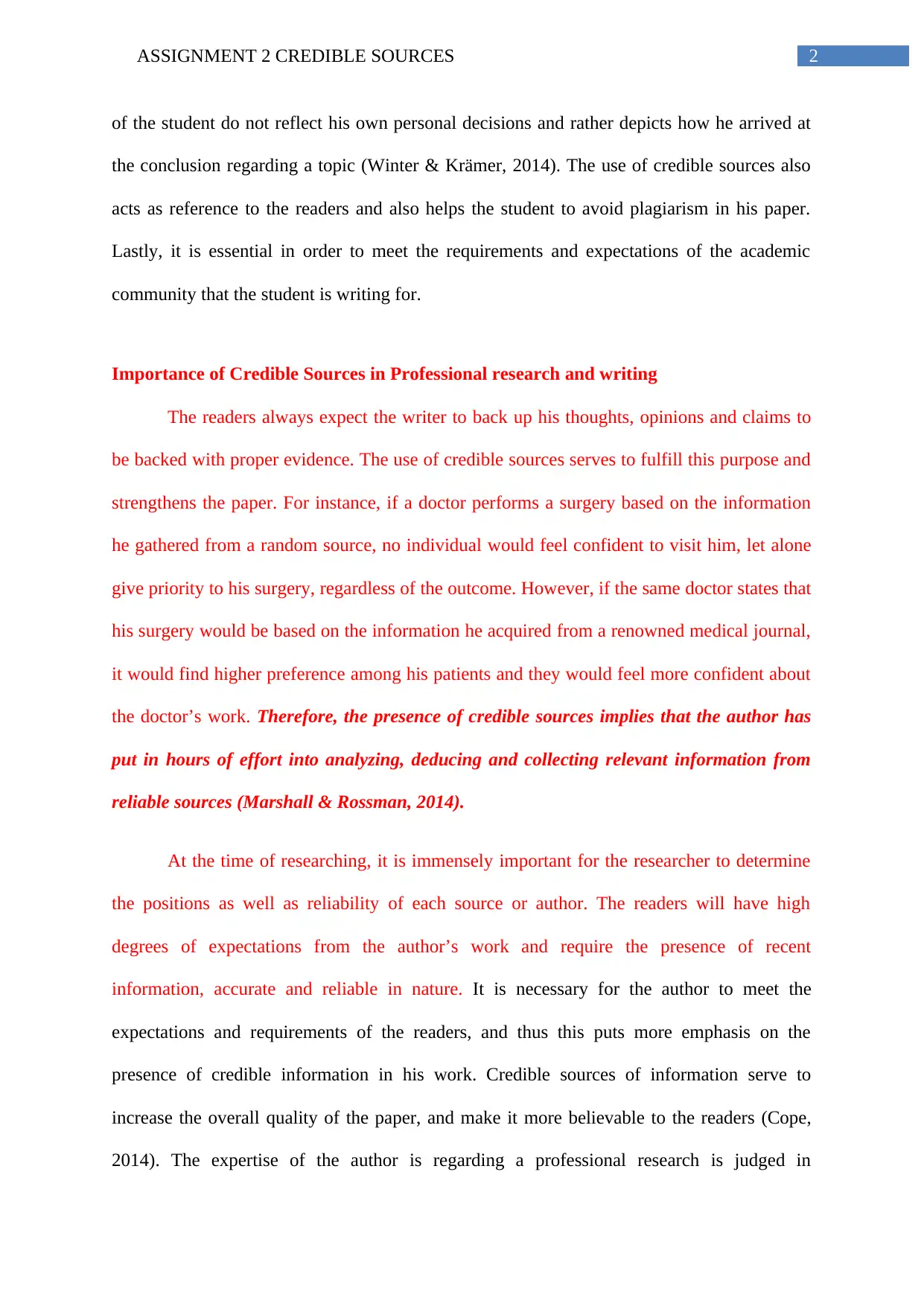
2ASSIGNMENT 2 CREDIBLE SOURCES
of the student do not reflect his own personal decisions and rather depicts how he arrived at
the conclusion regarding a topic (Winter & Krämer, 2014). The use of credible sources also
acts as reference to the readers and also helps the student to avoid plagiarism in his paper.
Lastly, it is essential in order to meet the requirements and expectations of the academic
community that the student is writing for.
Importance of Credible Sources in Professional research and writing
The readers always expect the writer to back up his thoughts, opinions and claims to
be backed with proper evidence. The use of credible sources serves to fulfill this purpose and
strengthens the paper. For instance, if a doctor performs a surgery based on the information
he gathered from a random source, no individual would feel confident to visit him, let alone
give priority to his surgery, regardless of the outcome. However, if the same doctor states that
his surgery would be based on the information he acquired from a renowned medical journal,
it would find higher preference among his patients and they would feel more confident about
the doctor’s work. Therefore, the presence of credible sources implies that the author has
put in hours of effort into analyzing, deducing and collecting relevant information from
reliable sources (Marshall & Rossman, 2014).
At the time of researching, it is immensely important for the researcher to determine
the positions as well as reliability of each source or author. The readers will have high
degrees of expectations from the author’s work and require the presence of recent
information, accurate and reliable in nature. It is necessary for the author to meet the
expectations and requirements of the readers, and thus this puts more emphasis on the
presence of credible information in his work. Credible sources of information serve to
increase the overall quality of the paper, and make it more believable to the readers (Cope,
2014). The expertise of the author is regarding a professional research is judged in
of the student do not reflect his own personal decisions and rather depicts how he arrived at
the conclusion regarding a topic (Winter & Krämer, 2014). The use of credible sources also
acts as reference to the readers and also helps the student to avoid plagiarism in his paper.
Lastly, it is essential in order to meet the requirements and expectations of the academic
community that the student is writing for.
Importance of Credible Sources in Professional research and writing
The readers always expect the writer to back up his thoughts, opinions and claims to
be backed with proper evidence. The use of credible sources serves to fulfill this purpose and
strengthens the paper. For instance, if a doctor performs a surgery based on the information
he gathered from a random source, no individual would feel confident to visit him, let alone
give priority to his surgery, regardless of the outcome. However, if the same doctor states that
his surgery would be based on the information he acquired from a renowned medical journal,
it would find higher preference among his patients and they would feel more confident about
the doctor’s work. Therefore, the presence of credible sources implies that the author has
put in hours of effort into analyzing, deducing and collecting relevant information from
reliable sources (Marshall & Rossman, 2014).
At the time of researching, it is immensely important for the researcher to determine
the positions as well as reliability of each source or author. The readers will have high
degrees of expectations from the author’s work and require the presence of recent
information, accurate and reliable in nature. It is necessary for the author to meet the
expectations and requirements of the readers, and thus this puts more emphasis on the
presence of credible information in his work. Credible sources of information serve to
increase the overall quality of the paper, and make it more believable to the readers (Cope,
2014). The expertise of the author is regarding a professional research is judged in
⊘ This is a preview!⊘
Do you want full access?
Subscribe today to unlock all pages.

Trusted by 1+ million students worldwide
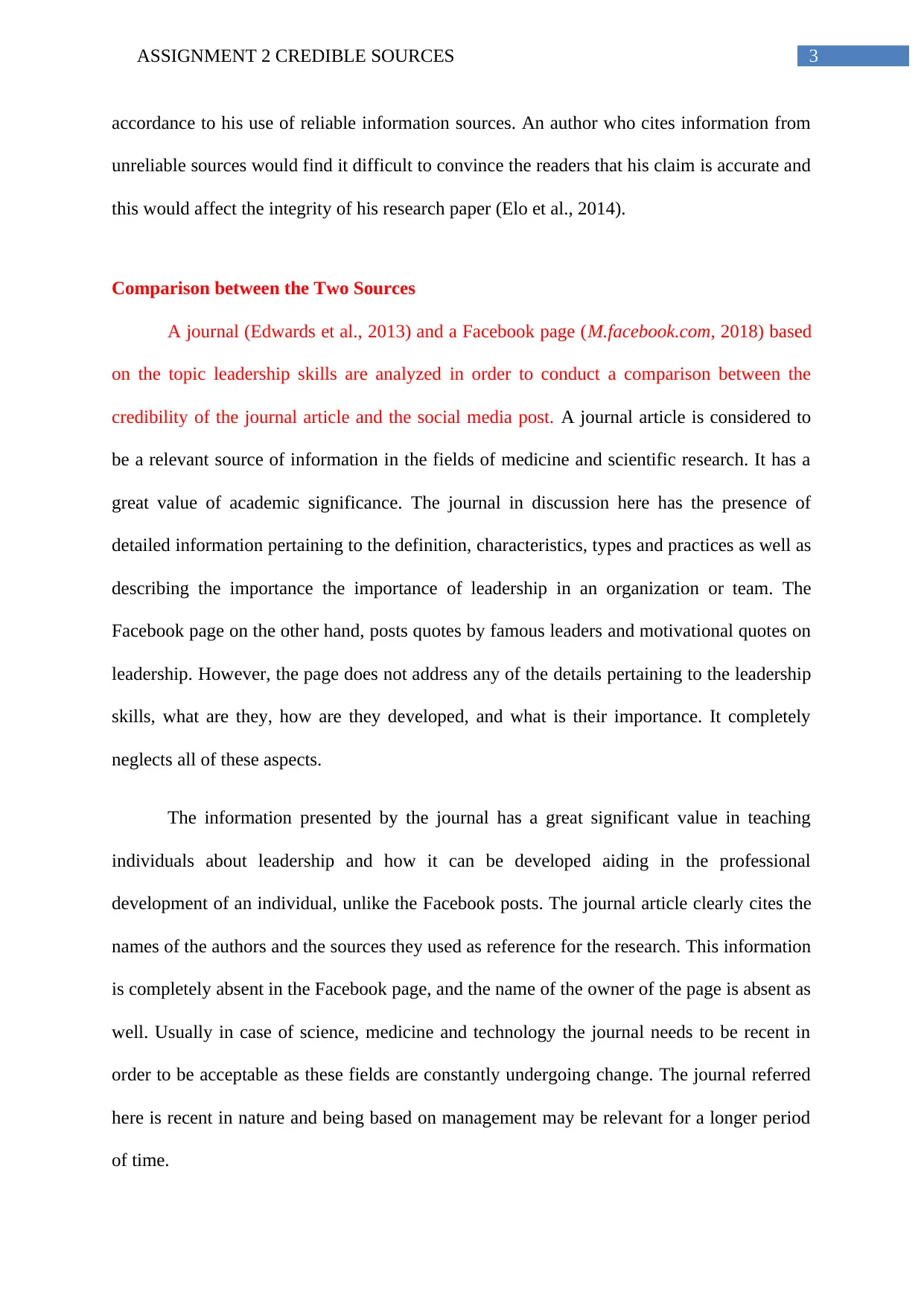
3ASSIGNMENT 2 CREDIBLE SOURCES
accordance to his use of reliable information sources. An author who cites information from
unreliable sources would find it difficult to convince the readers that his claim is accurate and
this would affect the integrity of his research paper (Elo et al., 2014).
Comparison between the Two Sources
A journal (Edwards et al., 2013) and a Facebook page (M.facebook.com, 2018) based
on the topic leadership skills are analyzed in order to conduct a comparison between the
credibility of the journal article and the social media post. A journal article is considered to
be a relevant source of information in the fields of medicine and scientific research. It has a
great value of academic significance. The journal in discussion here has the presence of
detailed information pertaining to the definition, characteristics, types and practices as well as
describing the importance the importance of leadership in an organization or team. The
Facebook page on the other hand, posts quotes by famous leaders and motivational quotes on
leadership. However, the page does not address any of the details pertaining to the leadership
skills, what are they, how are they developed, and what is their importance. It completely
neglects all of these aspects.
The information presented by the journal has a great significant value in teaching
individuals about leadership and how it can be developed aiding in the professional
development of an individual, unlike the Facebook posts. The journal article clearly cites the
names of the authors and the sources they used as reference for the research. This information
is completely absent in the Facebook page, and the name of the owner of the page is absent as
well. Usually in case of science, medicine and technology the journal needs to be recent in
order to be acceptable as these fields are constantly undergoing change. The journal referred
here is recent in nature and being based on management may be relevant for a longer period
of time.
accordance to his use of reliable information sources. An author who cites information from
unreliable sources would find it difficult to convince the readers that his claim is accurate and
this would affect the integrity of his research paper (Elo et al., 2014).
Comparison between the Two Sources
A journal (Edwards et al., 2013) and a Facebook page (M.facebook.com, 2018) based
on the topic leadership skills are analyzed in order to conduct a comparison between the
credibility of the journal article and the social media post. A journal article is considered to
be a relevant source of information in the fields of medicine and scientific research. It has a
great value of academic significance. The journal in discussion here has the presence of
detailed information pertaining to the definition, characteristics, types and practices as well as
describing the importance the importance of leadership in an organization or team. The
Facebook page on the other hand, posts quotes by famous leaders and motivational quotes on
leadership. However, the page does not address any of the details pertaining to the leadership
skills, what are they, how are they developed, and what is their importance. It completely
neglects all of these aspects.
The information presented by the journal has a great significant value in teaching
individuals about leadership and how it can be developed aiding in the professional
development of an individual, unlike the Facebook posts. The journal article clearly cites the
names of the authors and the sources they used as reference for the research. This information
is completely absent in the Facebook page, and the name of the owner of the page is absent as
well. Usually in case of science, medicine and technology the journal needs to be recent in
order to be acceptable as these fields are constantly undergoing change. The journal referred
here is recent in nature and being based on management may be relevant for a longer period
of time.
Paraphrase This Document
Need a fresh take? Get an instant paraphrase of this document with our AI Paraphraser
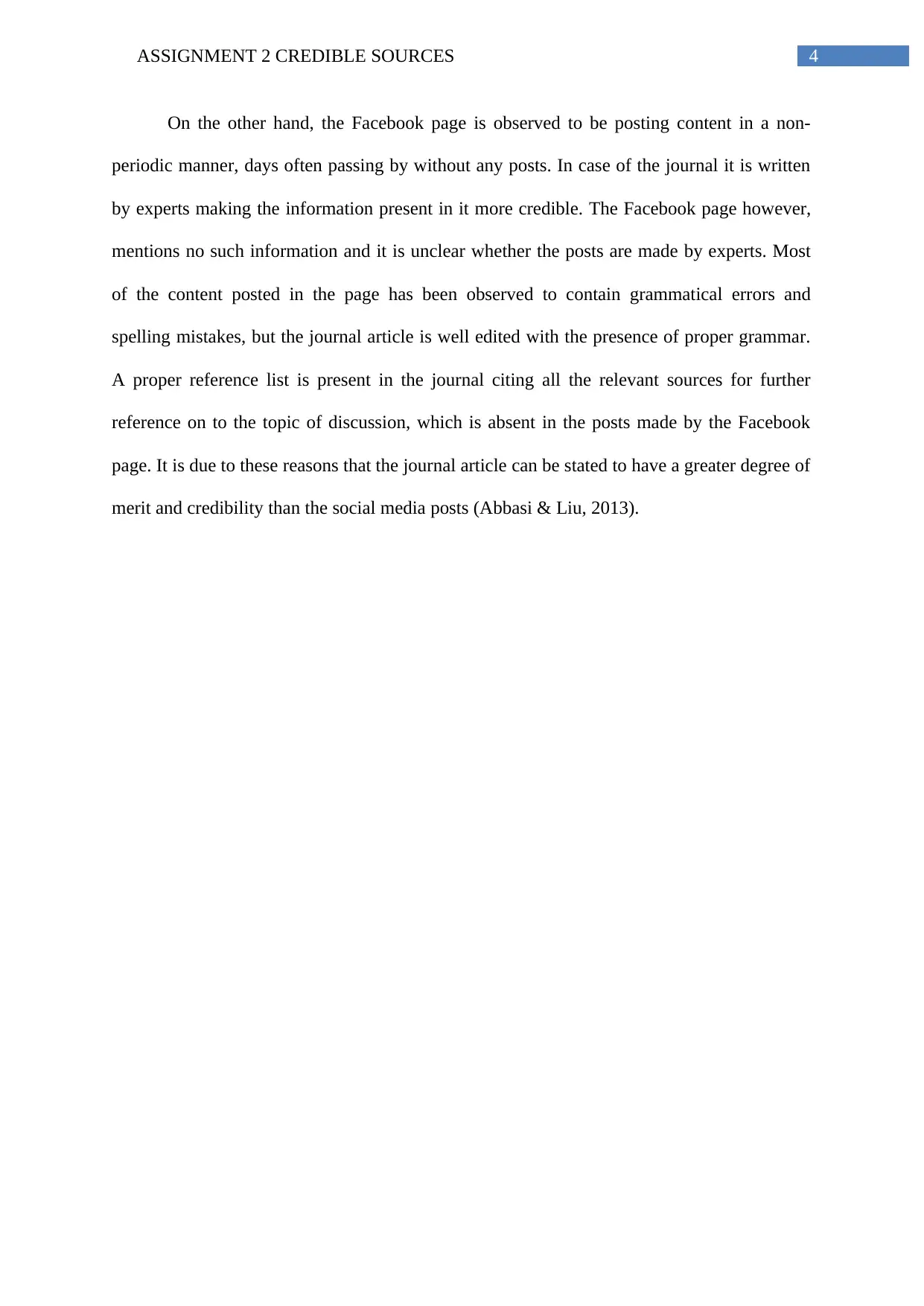
4ASSIGNMENT 2 CREDIBLE SOURCES
On the other hand, the Facebook page is observed to be posting content in a non-
periodic manner, days often passing by without any posts. In case of the journal it is written
by experts making the information present in it more credible. The Facebook page however,
mentions no such information and it is unclear whether the posts are made by experts. Most
of the content posted in the page has been observed to contain grammatical errors and
spelling mistakes, but the journal article is well edited with the presence of proper grammar.
A proper reference list is present in the journal citing all the relevant sources for further
reference on to the topic of discussion, which is absent in the posts made by the Facebook
page. It is due to these reasons that the journal article can be stated to have a greater degree of
merit and credibility than the social media posts (Abbasi & Liu, 2013).
On the other hand, the Facebook page is observed to be posting content in a non-
periodic manner, days often passing by without any posts. In case of the journal it is written
by experts making the information present in it more credible. The Facebook page however,
mentions no such information and it is unclear whether the posts are made by experts. Most
of the content posted in the page has been observed to contain grammatical errors and
spelling mistakes, but the journal article is well edited with the presence of proper grammar.
A proper reference list is present in the journal citing all the relevant sources for further
reference on to the topic of discussion, which is absent in the posts made by the Facebook
page. It is due to these reasons that the journal article can be stated to have a greater degree of
merit and credibility than the social media posts (Abbasi & Liu, 2013).
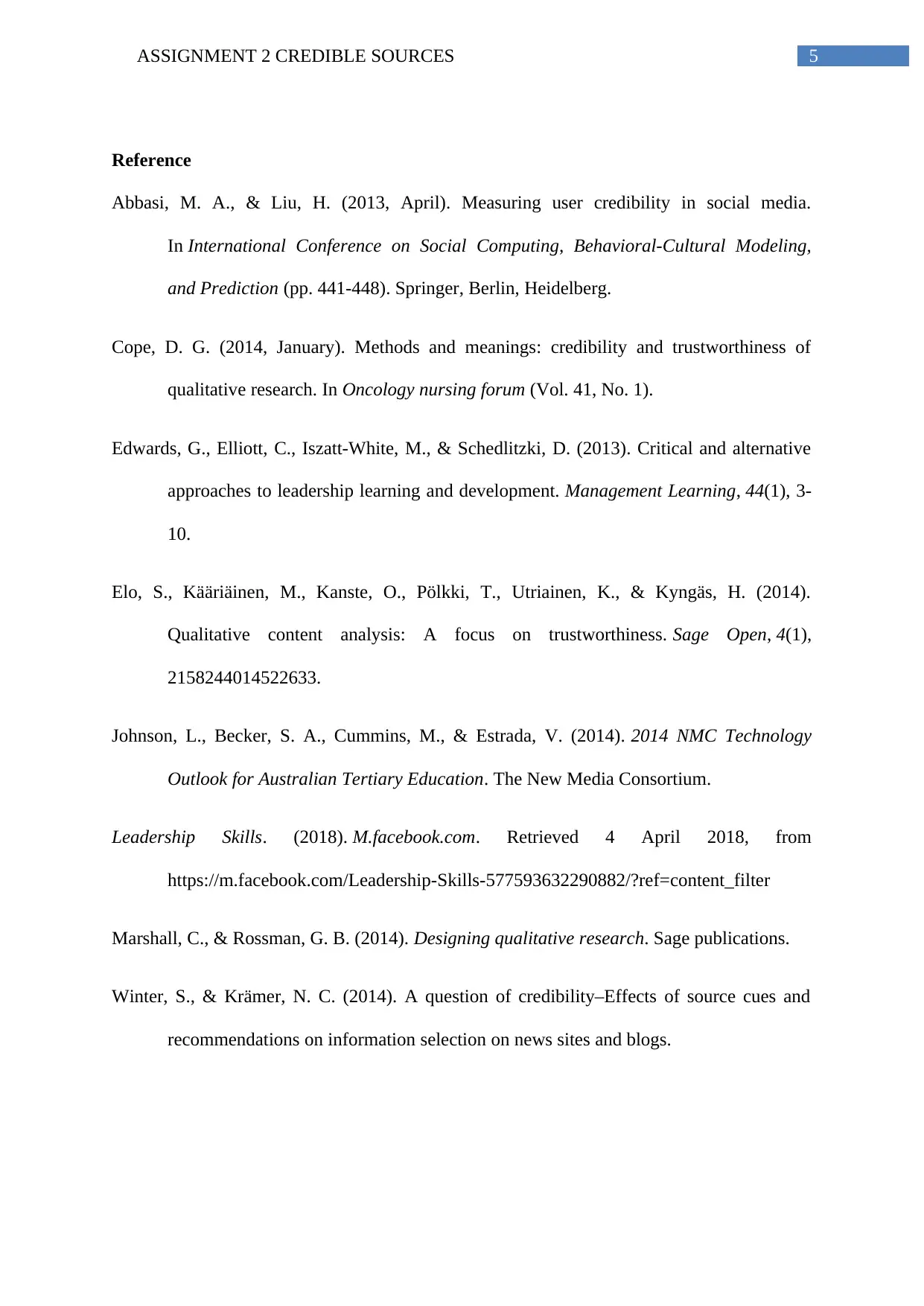
5ASSIGNMENT 2 CREDIBLE SOURCES
Reference
Abbasi, M. A., & Liu, H. (2013, April). Measuring user credibility in social media.
In International Conference on Social Computing, Behavioral-Cultural Modeling,
and Prediction (pp. 441-448). Springer, Berlin, Heidelberg.
Cope, D. G. (2014, January). Methods and meanings: credibility and trustworthiness of
qualitative research. In Oncology nursing forum (Vol. 41, No. 1).
Edwards, G., Elliott, C., Iszatt-White, M., & Schedlitzki, D. (2013). Critical and alternative
approaches to leadership learning and development. Management Learning, 44(1), 3-
10.
Elo, S., Kääriäinen, M., Kanste, O., Pölkki, T., Utriainen, K., & Kyngäs, H. (2014).
Qualitative content analysis: A focus on trustworthiness. Sage Open, 4(1),
2158244014522633.
Johnson, L., Becker, S. A., Cummins, M., & Estrada, V. (2014). 2014 NMC Technology
Outlook for Australian Tertiary Education. The New Media Consortium.
Leadership Skills. (2018). M.facebook.com. Retrieved 4 April 2018, from
https://m.facebook.com/Leadership-Skills-577593632290882/?ref=content_filter
Marshall, C., & Rossman, G. B. (2014). Designing qualitative research. Sage publications.
Winter, S., & Krämer, N. C. (2014). A question of credibility–Effects of source cues and
recommendations on information selection on news sites and blogs.
Reference
Abbasi, M. A., & Liu, H. (2013, April). Measuring user credibility in social media.
In International Conference on Social Computing, Behavioral-Cultural Modeling,
and Prediction (pp. 441-448). Springer, Berlin, Heidelberg.
Cope, D. G. (2014, January). Methods and meanings: credibility and trustworthiness of
qualitative research. In Oncology nursing forum (Vol. 41, No. 1).
Edwards, G., Elliott, C., Iszatt-White, M., & Schedlitzki, D. (2013). Critical and alternative
approaches to leadership learning and development. Management Learning, 44(1), 3-
10.
Elo, S., Kääriäinen, M., Kanste, O., Pölkki, T., Utriainen, K., & Kyngäs, H. (2014).
Qualitative content analysis: A focus on trustworthiness. Sage Open, 4(1),
2158244014522633.
Johnson, L., Becker, S. A., Cummins, M., & Estrada, V. (2014). 2014 NMC Technology
Outlook for Australian Tertiary Education. The New Media Consortium.
Leadership Skills. (2018). M.facebook.com. Retrieved 4 April 2018, from
https://m.facebook.com/Leadership-Skills-577593632290882/?ref=content_filter
Marshall, C., & Rossman, G. B. (2014). Designing qualitative research. Sage publications.
Winter, S., & Krämer, N. C. (2014). A question of credibility–Effects of source cues and
recommendations on information selection on news sites and blogs.
⊘ This is a preview!⊘
Do you want full access?
Subscribe today to unlock all pages.

Trusted by 1+ million students worldwide
1 out of 6
Related Documents
Your All-in-One AI-Powered Toolkit for Academic Success.
+13062052269
info@desklib.com
Available 24*7 on WhatsApp / Email
![[object Object]](/_next/static/media/star-bottom.7253800d.svg)
Unlock your academic potential
Copyright © 2020–2025 A2Z Services. All Rights Reserved. Developed and managed by ZUCOL.





